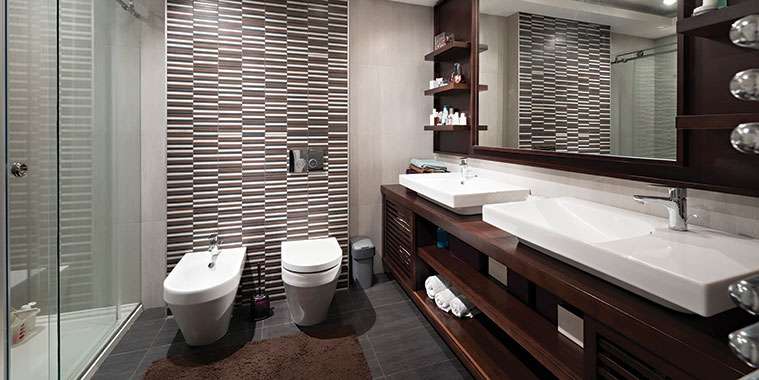Past pandemics radically changed home design. Easy-to-disinfect subway tiles became a kitchen mainstay, half-bathrooms became commonplace and screened-in porches that were once for the sick, were transformed into backyard oases.
Although we’re far from the end of the coronavirus, home design experts are already predicting a shift toward health-conscious home design. Features such as antimicrobial materials, no-touch fixtures and hospital-grade air purifiers, and additional bathrooms could all become the norm to make our homes a formidable fortress against a future viral threat.
Here’s what could be on your future must-have list:
Bidets and smart toilets
Although the toilet paper craze has simmered down, the few weeks where it was a rare commodity pushed us toward using bidets more than ever. Bidet startup Tushy reported record sales with two of its three models selling out until April.
Home designers expect bidets to stick around after the pandemic since they reduce the need for toilet paper and are considered a more hygienic way to clean.
“Bidets are gentle and hygienic, and even when TP is back on store shelves, these devices will still be in demand,” wellness design consultant Jamie Gold told realtor.com
If you want additional hygienic benefits from your toilet, HomeAdvisor Smart Home Strategist Dan
DiClerico suggests investing in a smart toilet with air drying and antimicrobial UV lighting to sanitize your seat.
“I didn’t put a smart toilet in the master bathroom when we renovated a couple of years ago, and it’s been one of my biggest regrets,” he noted.
Additional bathrooms
After the 1918 Spanish Flu pandemic, half-bathrooms became a necessity as homeowners strove to keep visitors (and their potential germs) away from their family’s main restroom. The average North American home has two bathrooms for every three bedrooms, but future homebuyers may require one bathroom for every bedroom so if a family member falls sick, they can have their own bathroom.
“In the last 50 years, the number of home bathrooms per person has doubled,” Yuko wrote in an article for City Lab. “One could easily see the lavatory-building boom accelerate further as future homeowners keep the needs of the self-quarantined in mind.”
Mudrooms
Before the pandemic, most people put little thought into how they entered their homes. Want to plop your purse on the counter? No problem. Have a little mud on your shoes? Just give them a quick rub on the mat before entering. Ready to shed a sweaty jacket? Just throw it on the nearest seat.
However, many of us have adopted complicated routines that include wearing masks and carefully
removing clothes and shoes for fear of bringing the virus into our homes. So, what’s the solution? Mudrooms.
“In the future, even once we ditch the masks and gloves, we may still think a little differently about our entryways,” Real Simple‘s staff shared in a recent article. “The return of the mudroom, or an antechamber between the front door and the house, provides the ideal spot to remove shoes, hang up jackets, and slather on sanitizer before stepping inside.”
Antimicrobial or touch-free fixtures
While stainless steel became the standard in North American kitchens and bathrooms for its sleekness, the New England Journal of Medicine determined it’s not the best surface for keeping germs at bay.
As a result, home designers expect buyers to favor homes with copper and ceramic. Both have
antibacterial properties, and viruses like COVID-19 only live on these surfaces for a few hours compared to 24 hours on stainless steel.
“Ceramic tile is another positive way to keep your family safe from bacteria because it is a solid surface that does not break down with the use of steam or cleaning solutions,” builder Thomas Jeffrey said.
“Kitchen and bathroom sinks are among the most frequently used items in the home, so opting for a copper sink can play a powerful role in maintaining a truly sanitary environment,” stated designer Naomi Neilson. “It is a beautiful, sustainable, and highly practical material.”
If you’re not ready to part with stainless steel, then touch-free faucets may be the best option. There are options that cost as low as $50, but more stylish faucets can cost more than $1,000.
Home offices
The most obvious change will be the request for office space. For those of us who normally don’t work from home, our kitchens, bedrooms and living rooms have become makeshift offices until we’re able to safely re-enter an office.
Although smaller homes may not have room for a full office, kitchen nooks may become a popular alternative for homeowners who want a dedicated space to store their computer and other office necessities.
“As people video chat and Zoom more with colleagues from home, they’re becoming hyperaware of the changes they’d like to see in a home office, including better lighting and more storage,” home renovator David Sipp told realtor.com “And since a return to the workplace will be gradual, high demand will continue for an office that’s comfortable and functional.”
Cutting-edge air filtration systems
Although scientists are still researching the fine details of how long the coronavirus lingers in the air after a cough or sneeze, homeowners may be inspired to take matters into their own hands with high-powered air filtration systems.
“Water and air filtration systems tend to be seen as an unnecessary addition, easily abandoned in [favor] of a designer table,” Ukrainian architect Sergey Makhno wrote in an op-ed for Dezeen magazine. “But, manufacturers of smart home systems will go one step further.”
“Their programs will not only control the temperature of the air in the house, but also its quality and, if necessary, they will automatically clean it. Air from the outside will, of course, be filtered,” he added.
Although a hi-tech air filtration system likely isn’t in most of our budgets, a review of our HVAC system probably is.
“Even as we await the scientific evidence [about HEPA filters], the novel respiratory disease, coupled with more time spent at home, is making many of us rethink our indoor air quality,” Real Simple said. “Replacing or upgrading the filters in HVAC units in homes, as well as investing in air purifiers for homes and apartments, may soon become a top priority.”
— Inman News



